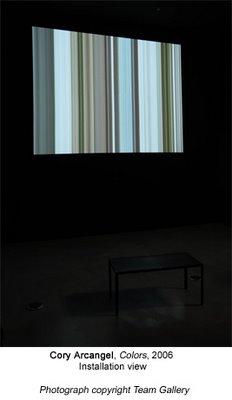View current page
...more recent posts
"Ratatouille is a nearly flawless piece of popular art," writes A. O. Scott of the New York Times, in a review accompanied by this picture:
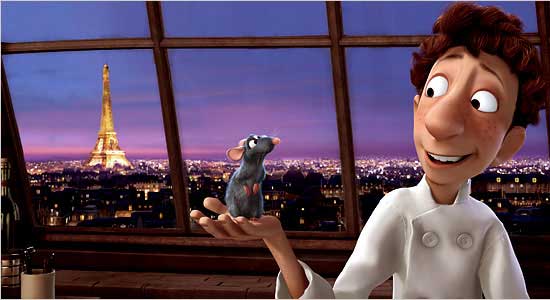
Stephanie Zacharek in Salon calls it "one of the most beautiful animated pictures I've ever seen," in a review accompanied by this picture:

Any student or critic of art, popular or unpopular, knows why these statements are wrong and what's missing from these images and these movies (also Shrek, the Incredibles, Toy Story, and the rest): line. For reasons mostly of budget and a kind of unthinking rush to modernize, filmmakers have thrown out possibly the central tool in the history of visual expression, and replaced it with tricks of sfumato and chiaroscuro that give objects a rounded, "realistic" look but make everything in the frame bulbous and doughy. It would be like making music with no "attack transients" (sharp sounds at the beginning of notes that give them their texture and bite)--all music would become billowy and ersatz, like New Age music. Years after photography mooted realistic painting in the world of portraits and "scenes," these Tinseltown hacks persist in imitating photographic depth, using computer short cuts, and the results are often simply grotesque (see above--eyes without lashes that are merely encircled by reptilian lids).
It's not a fluke that Toy Story "pioneer" Jon Lasseter worships Japanese animator Hayao Miyazaki and has given his films a boost in the US. It's guilt from a fast food franchise owner at all the excellent cuisine he's displaced. Miyazaki is a poet of line.
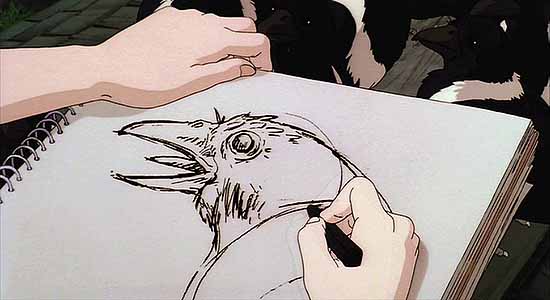

So expressive! Whereas Pixar and its offspring have the smooth, slightly frozen look of '70s album cover illustration done with an airbrush:

A topic for another day: the Pixar movies are also the embodiment of Disney Values. The plucky little guy triumphs over adversity and learns a valuable lesson. Whereas in real life plucky little guys have boots in their faces all over town, while the big entities (such as entertainment conglomerates) grow more and more dominant.

On the National Symphony's program of videogame music* at the Kennedy Center in Washington DC, here are the
RAVE REVIEWS!* "Live orchestral music with cutting-edge video screen visuals from Halo, Mario, Zelda, Warcraft, Metal Gear Solid, Kingdom Hearts, Sonic, Everquest II, God of War, Medal of Honor, Myst, Tron, and a classic arcade medley from Pong to Donkey Kong" [hat tip shm]
Los Angeles Times: "A GROUNDBREAKING SHOW! Video game music has come a long way from monotone bleeps to full-blown orchestral, choral, and opera arrangements. This fully choreographed tribute highlights the best games and their best features, whether it's the full choir accompanying Halo or the light show complementing Tron."
USA Today: "This spectacle is just the latest sign that songs written for the interactive gaming world are blasting out of consoles and into the mainstream!"
The Washington Times: "Video games are attracting serious composing talent!"
MTV.com: "If your idea of a hot Saturday night is a few hours of Xbox and a trip to the local Pink Floyd laser-light show, then Video Games Live is your dream date!"
Keywords: adolescent impulse dig dug
"Vox Computational" [mp3 removed]
Update: The chimy percussion in the chorus was bugging me so I redid this. The track has subtler percussion (an octave lower, plus a new "high" chime), a vibrato synth wail before the break, and it's been remixed.
Update 2: A couple of notes sounded out of tune to me, so I fixed them.
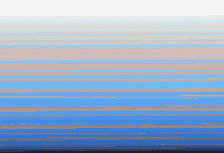







remix of work by Oliver Laric. A full size version (too big for the present page) is here.
not intended for RSS readers

Belatedly discovered Bleep.com, an electronic music site specializing in, um, bleepy dance music of recent vintage (and some classics). The mp3s cost money, but I'd pay a little for decent quality DRM-free mp3s of such things I've been looking for (or just came across on their site) as: A Guy Called Gerald's Black Secret Technology, miscellaneous early Black Dog, previously unreleased Swayzak tracks, Elektroids Elektroworld, CiM CDs I don't have, and Lab Rat XL (a Drexciya alias). The site is all about labels, which I don't really get at this point--with no CD printing or promotional costs, why is another middleman between musician and the public necessary?









GIF by unknown artist X 9
From Curbed:
Intellectually, we always understood that the far-more-attractive-than-it-needed-to-be temporary PATH Transit Hub at the World Trade Center site wouldn't be with us forever, but seeing photos of the rubble on the just-demolished site is, nonetheless, jarring. Writes our phototipster BrianVan, "I'd think they'd at least be a little less brazen than this. The nicest temporary transit station New York's ever had, gone forever. (But soon to be replaced by that Calatrava wings thing.)"If you know a structure is going to be up for only two years, build something that can be taken apart and assembled elsewhere. Don't smash it and then melt it for scrap. This photo is sickening. Way to go, Port Authority.
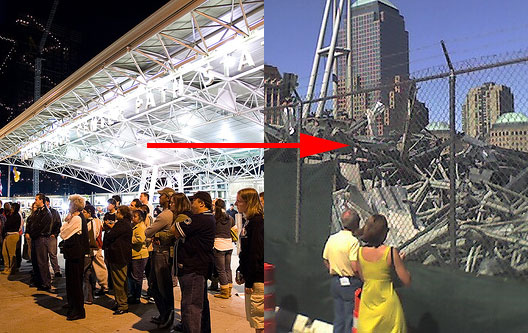
Protein synthesis as an epic hippie folk dance (classroom film--1971): [YouTube, via Patrick May in AFC's comments]
More on the Rhizome 2007-2008 Commissions, from the comments:
The part of your post that bothered me was where you talked about ShiftSpace. This is a great project. The trend of Web 2.0 has been to wrest order from the chaos of the early web; ShiftSpace is a project that intends to re-inject this spirit of anarchy. For example, the comment criticizing your writing ("how long has your criticism sucked") was removed from this page; ShiftSpace would allow this comment to remain on the page for other users to see. It could be read as a critique of the increasingly moderated Wikipedia, and it's attempt at "authoritativeness"; it's infused with nostalgia for the early web when people produced their own messy pages instead of buying into the myspace prefab system; it's a classic example of a "not just art" project. [...]
- anonymous (guest) 6-24-2007 7:28 pm
With much of this art the proposal is the work. Once you've come up with your sentence explaining the tech innovation and how it benefits others you're done.
[...]
The comment criticizing my writing ("how long has your criticism sucked") was fictional. [...] You assumed it was real and I deleted it--interesting.
-tom moody [6-24-2007 8:03 pm, 6-24-2007 8:13 pm]
I would agree that "the proposal is the work" if I wasn't aware of how many artists do a terrible job of writing about their work. Those sentences usually end up being a pale reflection of the work. [...]
- anonymous (guest) 6-24-2007 8:32 pm
The goals of ShiftSpace do indeed sound worthwhile and noble but I have to confess I'm not very interested in art as sociopolitical activism, especially when the success of the project is presumed in the proposal.
I'm as concerned as the next person about the constrictions of these social networking sites but feel the way to approach them is to go elsewhere, and if there's no elsewhere then lobby for more elsewhere.
It feels like a contradiction to apply for a grant to an institution so you can be an anarchist, especially when the steps of your anarchy are carefully planned out and result in another ordered system.
- tom moody 6-25-2007 8:51 am
(previous comment self-edited for tone, substance--ShiftSpace would reveal my first draft--great)
- tom moody 6-25-2007 8:53 am

"Blowout (YT Remix)" [mp3 removed]
Audio remix of a YouTube posted to Nasty Nets [link removed].
Caveat: Some might describe this as "off color."
Since at least the '60s philosopher Walter Benjamin's essay "The Work of Art in the Age of Mechanical Reproduction" has been a favorite for conceptualist artists working with imagery to cite in support of their work whether it actually supports it or not. Benjamin's style is murky and delphic compared to say, Clement Greenberg's, making it easier for people to pick and choose suitable phrases from it, even though much of "WAAMR"'s content was aimed at a very specific set of political circumstances (the rise of fascism in the '30s--the print era) that would seem to make it inapplicable to someone making present day art. To the extent it is used as the basis for a discussion of multiples vs originals in the art market it is a blueprint for boredom, and not good boredom. That kind of talk is dull because it's mostly about money--the context here was Creative Commons licenses and how much freedom they give the artist to also sell work.
The "here" in the last sentence is a discussion over at Paddy Johnson's blog between artist Nathaniel Stern and commenter David McBride. McBride attempts to correct Stern's reading of the Benjamin essay and then they spend several paragraphs wrangling over what the essay means, both back in the day and now. It doesn't help that the two aren't speaking the same language: Stern uses "meme" as an adjective ("meme'd") and McBride thinks he means "copied"; Stern thinks "aura" as Benjamin uses it is a form of "value" (it was really more like "residue of religious power"). Then there's the question of whether "to exploit" is good or bad. These appear to be generational misunderstandings. In any case the back and forth is interesting, if only to convince you to stay out of Benjamin country and stick to something informative and fun like "Avant Garde & Kitsch."
More commentary on the 2007-2008 Rhizome.org commissions Considered as XYZ Art post. People aren't offering any specific examples of where the analysis fails, they're mostly just telling me to shut up.
you could also apply the XYZ method to art criticism: take artwork X, apply categorization schema Y, produce art review Z.
- anonymous (guest) 6-21-2007 3:52 pm
You could, but some specifics would help.
I'm not sure there are any categorization schema any more except the old reliable, "mere description."
- tom moody 6-21-2007 4:46 pm
Right. Then why are you using the XYZ schema to critique art? As a critical process, it is more reductionist than the creative processes that you are criticizing.
- anonymous (guest) 6-21-2007 5:12 pm
Well, we disagree, there.
I'm flattered if you think XYZ is a critical methodology, or as you say "categorization schema."
I think the point of your comments is that it would be better not to question the Rhizome commissions.
Either that or there are so many other ways of critiquing them being articulated out there that mine should be disregarded as the weakest alternative.
R--i-i-ight.
- tom moody 6-21-2007 6:02 pm








































































GIF by unknown artist X 72
Every Enemy is Al Qaeda Now
Bush and the U.S. press continue their collusive spin thing. Glenn Greenwald in Salon (may be behind subscription firewall):
That the Bush administration, and specifically its military commanders, decided to begin using the term "Al Qaeda" to designate "anyone and everyone we fight against or kill in Iraq" is obvious. All of a sudden, every time one of the top military commanders describes our latest operations or quantifies how many we killed, the enemy is referred to, almost exclusively now, as "Al Qaeda."
But what is even more notable is that the establishment press has followed right along, just as enthusiastically. I don't think the New York Times has published a story about Iraq in the last two weeks without stating that we are killing "Al Qaeda fighters," capturing "Al Qaeda leaders," and every new operation is against "Al Qaeda."
The Times -- typically in the form of the gullible and always-government-trusting "reporting" of Michael Gordon, though not only -- makes this claim over and over, as prominently as possible, often without the slightest questioning, qualification, or doubt. If your only news about Iraq came from The New York Times, you would think that the war in Iraq is now indistinguishable from the initial stage of the war in Afghanistan -- that we are there fighting against the people who hijacked those planes and flew them into our buildings: "Al Qaeda."










































Compare and contrast:
Kristin Lucas, Host, 1997 (Quicktime excerpt clickable here [not anymore--thanks EAI!!!], or rather, here)
and
Paul Slocum, Hats, 2007 (YouTube)
Update: 12 hours later, and none of you have turned in your essays. I think these pieces are very similar and say much about the media (and assumptions about media) prevalent at the time they were made.
1. Both take place within a screen space, with inset headshot windows, and involve two characters talking (or not) at cross purposes to each other.
2. The Lucas is a quasi-science fiction scenario playing on the Logan's Run/THX1138 trope of the "video confessional." Lucas tells her troubles to an ATM camera, but instead of Big Brother or Sister, an overworked, headset-wearing operator (also Lucas) mostly ignores her while putting out fires on other networks. POVs are looking out from the ATM at the patient/confessor on the street, the operator/shrink on an inset screen, and an awkward exchange where the shrink tries to tell the patient where to touch the screen to get a response.
3. In Slocum's piece the action takes place on a present-day, cluttered computer desktop. Two video inset windows frame Slocum and another character, who might be videoconferencing. The headset-wearing Slocum is mostly just listening and lurking, opening and closing desktop windows as the page strains from the taxing of memory. He recalls the "operator" in the Lucas video, managing chaos and not accomplishing much. The other character is not a penitent from the street but a guy on YouTube confessing his girlfriend problems, and not to Slocum but the world. His voice cuts in and out and repeats.
4. 1997: closed network, centrally controlled, falling apart from an absence of qualified human "controllers," yet there is still faith in the system by the users.
5. 2007: open network, peer to peer, but communication no better--YouTube is a one way confession, screen is clogged with noise of too many cyberentertainment distractions. Users still think confessing (to a social networking site) will solve their problems.
6. Both pieces are complex and layered and make adroit use their respective media to evoke maximum cognitive dissonance.
7. Both works introduce subject matter extraneous to a simple two character narrative. Lucas' operator appears to be splitting her time between her "confessional" clients and managing some sort of group videogame environment (this may not be apparent on the excerpted clip). The contours of her activities are porous and uncertain. Half of Slocum's screen space is taken up with a banal jpeg of baseball hats on an armchair, along with a confused multiplicity of windows opening and closing as well as overlapping and interrupting the YouTube boob.
8. In both works the artists use their own image as a character or characters.
9. Lucas's screen environment is wholly fictional, but Slocum's might actually just be his desktop on a given day, heaven help him.
10. Both pieces are further nested within screen environments reflective of their eras. Lucas is Amiga computer- and analog-mixed video for TV display (converted to Quicktime for the Web by the non-profit Electronic Arts Intermix, which distributes the work). The Slocum piece is all-PC, using capture programs and other software, self-distributed via the YouTube (centrally, corporately controlled) video networking site.
11. Both pieces are linked to from the artist's personal websites. Lucas's has an archive linking to excerpted versions of the work (update: a longer one is here); Slocum's is in blog form and puts an embedded YouTube of the video in a post.

Selected group websurfing blogs:
Double Happiness
Supercentral
Nasty Nets (disclosure: I'm in this)
The heirs to SCREENFULL and 544x378(WebTV)? The latter were daily blogs with original audio and visual work, now sadly archived, that were heavy on recycled/mashed Internet/pop culture content. I suspect it was hard for two people (jimpunk and Abe Linkoln) to sustain that creative pitch, but with a group blog the work is distributed more evenly. Whether they'll last any longer is another question. All have a certain ad hoc quality that keeps them unpredictable but Internet creative chemistry is so flighty. On the other hand, what happens with real-world co-ops is that one or two people end up doing all the work (and therefore laying down rules for the others) but low overhead and a low bar to participation makes the Internet model potentially different. Still, someone has to deal with the nightmare of comment spam and other realities of the internet, even if all costs are shared equally.
Update: There is something on the Nasty Nets front page that is either crashing my browser or prompting me to install non-existent Quicktime add-ons. I think it is the embedded "Mr Wizard" file. (I have Firefox on a PC.) It will soon be gone from the front page after a couple more posts. It would be good if this could be fixed because I have a commenter blaming an excess of animated GIFs for "harming" his computer--this completely killed any discussion of the content of the page.
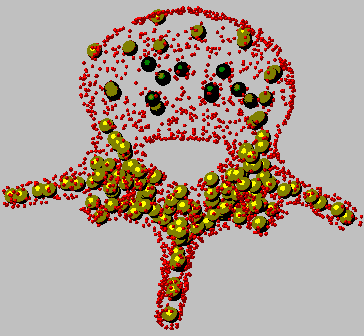
Today through Sunday are the final days for BLOG, the exhibition, where this weblog is being displayed as an ongoing performance work at artMovingProjects in Brooklyn, NY. There will be a closing party Sunday, June 24th. I will not be attending but will continue to perform from an undisclosed location. My blog "terminal" is in the project space; the main space features an installation by Zoe Sheehan Saldana, including some tobacco plants she has been growing in the gallery. These plants will be given away at the party. Please attend, and be sure to leave me a comment--as BLOG is "fully interactive."
Paddy Johnson discussed the show here; it is more a review of the blog than BLOG, which had only recently opened when she wrote it. She likes the critical and political side of the project and mostly sidesteps the issue of the cartoony molecular and quasi-scientific imagery that pops up here like clockwork. (The swimming pool piece she picked is unusually sedate for me.) I'm pleased to say many of the cartoony GIFs have "gone viral" on the Net--the lack of good taste in a critical context seems to be an asset elsewhere. Also, a fair amount of music gets posted here, and some video, and those have also found audiences. In my own defense I'll say the critical mind (to the extent it exists) leads to the inexorable conclusion of "bad boy" content.

hat tip to L.M.
"Whiskey Tango Fubar" [mp3 removed]
Expect there will be more variations of this, with different instruments, added harmonies, etc. I wrote the "main theme" while waiting for an out of town guest to come over for a studio visit. Originally it was all synth (the part that comes in in the middle) but I liked the relentlessness of it on the piano. The drum machine parts combine live and sampled hits (live as in live electronics). I wanted them kind of loose and desultory to contrast with the piano--all of this can be tightened and made more "classical."



Stephen Hendee, The Eye, New Britain Museum, New Britain, CT, USA, 2005
points of comparison to the Nathaniel Stern work in the previous post:
-specifically evokes "wireframe" computer model (or "invokes" in the case of Stern, who uses the word in his title)
-reproduces wireframe outlines as an actual object
-"problematizes" computer drawing with surrealist invention, deformation
-use of materials such as tape and foamcor (Hendee) and rope (Stern) suggests folk-like or cargo-cult-like reification or fetishization of high technology
-inverts the idea of a computer as effortless and airy through the conspicuous employment of hand labor
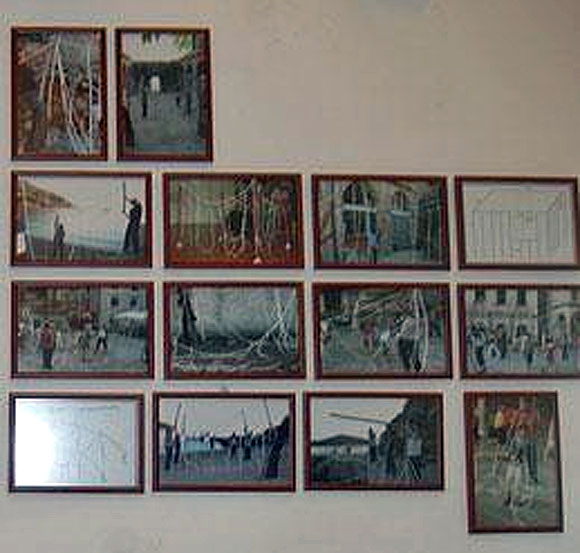
Apologies for the aggressive enlargement and resulting blurriness and artifacts in this photo by Joy Garnett. It's an installation of some photos of a performance work by Nathaniel Stern called The Wireframe Series: Sentimental Construction #1. Some clearer photos are here. This blog had its own wireframe aesthetics series a few years back so the topic is of interest. Paddy Johnson has little use for Stern's piece in her review of it today but it merits a stab at a long distance defense. The idea is to haul an Oldenburgized version of a 3-D computer drawing (what might be called "giant soft building outline") out into the streets of Dubrovnik and photograph people erecting it in the style of an Amish barn-raising. Thus hard becomes soft, virtual becomes actual, private becomes public. The sculpture is not of itself interesting--it is activated through its contact with people (like certain objects by Franz West or Helio Oiticica that were meant to be carried or worn) and by being photographed. In the photos, the softened or molten outlines of the rope building become a classic surrealistically "problematized" image, re-envisioning something hard and artificial as pliable and organic. They also represent a regression or devolution of the CAD-generated modernist box by being juxtaposed against the cobbled streets of an older Mediterranean city, and by their handling by real live human beings. Looks good from this side of the Atlantic and this side of the computer screen.

artist unknown--thanks to harm, who found it
The post on the Rhizome 2007-2008 commissions as XYZ Art (reblogged here, thanks cpb) elicited the following response:
Don't see how XYZ relates solely to these types of new media projects. Painting, sculpture, photography, many mediums use a trial-error process similar to science. For instance one commonly develops a style or signature process (the algorithm), often paying big gradschool dollars for it, then alters X strokes or colors, looks at the Z surface, changes X some, then goes for the super awesome Z for the finish. - ssrAnd my reply:
That's funny, but we're not talking about a trial-error process. It's more like one application: a single transformation of something into something that "helps others."
The art world equivalent would be a conceptual art work, something like Meg Cranston's Who's Who by Size, University of California Sample, 1994, where different fabric-covered sculptural stacks (Z) represent the number of inches of shelf space (X) that a subject (Edgar Allen Poe, Elvis Presley, etc) has in a college library. The algorithm or (Y) is assigning a fabric to the subject (Anna Pavlova in ballet slipper satin, etc) and making the stacks. The work has a point, and one point only, to show intuitively that "size matters" in assessing one's historical reputation. (I got this example and some of the description from the book Deep Storage, ed. by Ingrid Schaffner and Matthias Winzen.)
Grad schools turning out cookie cutter painting is rather a different issue.
etc:
spider car
cat vs TV reporter
super-pissed off cat
cat vs mini-helicopter
cobra vs baby (damn--"removed for terms of use violation"--oh, well)
from singe's journal
BruceB reconsiders the Niven & Pournelle science fiction novel The Mote in God's Eye in light of the "9/12 mentality" of Glenn Reynolds and other techno-class warmongers: "What most troubles me now is the glibness of it, the emphasis on the cleverness of the humans who see through the Motie deceptions, since this looms even larger than the courage of some humans who must die for the sake of plot developments. And itís completely callous about the wisdom and morality of just standing by and watching an entire society collapse into barbarism - since itís not the full-blown genocide some authorities had thought be necessary, itís an improvement, and it seems like since itís not genocide, itís A-OK. Other peopleís stuff is there to be exciting and interesting props, but it and its owners can be shoved around and broken up as need be, and what really matters (as presented in Mote) is the coolness of the humans whoíll do the pushing and breaking."
Science fiction/fabulist/slipstream/magic realist author A. A. Attanasio is beginning a new novel and letting readers look over his shoulder on his blog. He tucks the announcement into a longish post about a trip into the mountains of his native Hawaii, in the company of three elderly men who repair ancient shrines in the peaks, and the great-grandnephew of one of them, a young Marine who lost part of a leg in Fallujah:
The Marine shrugs. Clambering up the side of the colossal boulder and scouting from the top, he spies a cliff, which he believes we can climb to higher ground. I warn him that those trails are good for goats not people. He dismisses me and lumbers off into the fern maze. I would prefer to stay put and wait for the stonemovers to find us. But I can't let a friend's relative wander alone aimlessly, even though I have no idea where we are, and so the double leads me deeper into Adam's dream, a trance walk darkening toward nightmare.This open writing project will be a treat and it's entirely possible a new form of literature will start to emerge, just as art and music are changing with the advent of more porous boundaries among creator, consumer, and distributor. Few are better suited to the attempt than this writer with a strong posthuman thread in his fiction. His books to date (Radix, Centuries, Last Legends of Earth and others) are mind-expanding and there's no reason his blog can't be the same as he delves into this narrative.
Strenuously and repeatedly, I silently wish I had stayed home. This, of course, is the timeless desire to remain unborn and in the womb, the original (but not final) destination of the itinerant hero. Night descends before we find our way out of the grotto, and we crawl into our sleeping bags, pull up our mosquito cowls, and submit to the uterine regression of sleep and dreams.
On the way to dreamland, I work out some of the ideas for "Otherlight." The science inspiring the fiction is genetic amplification. Not long ago, I read about a genome wonder that entailed the inoculation of human DNA snippets (that code for color vision) directly into the eyeballs of color blind mice and monkeys and that immediately endowed these animals with color vision! The researchers were amazed at how quickly the recipient nervous systems went from b&w to color -- and that got me fantasizing about genetic transformations that could instantly add different senses, new ones, with a science fictional bent, like seeing other dimensions, parallel worlds ... and then not just seeing but interacting with and adventuring in alien universes. DNA in 10-space!
War Nerd:
What cracked me up is the way [neocon apologist Victor Davis] Hanson uses the spike in oil prices to prove we meant well: "What did these rare Americans not fight for? Oil, for one thing. The price skyrocketed after they went in."link not meant to endorse every excess of the Nerd's unPC writing, but his frankness is refreshing.
Now that's real underclassman-level logic: if we didn't manage to grab Iraq's oil fields, then we must never have wanted to.
Applying that to the Hitler example, Vic's take on the Eastern Front would be, "What was Operation Barbarossa not designed to do? Conquer Russia, for one thing. By 1945, Germany had actually lost massive chunks of territory, so clearly a land-grab was the last thing on Hitler's mind."
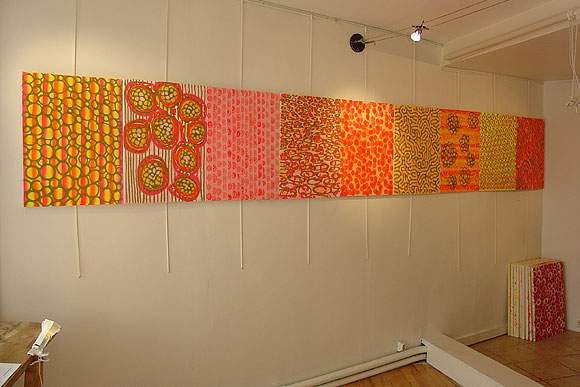
David Szafranski, installation view from a recent show in Montmartre, Paris, with Trish Nickell.
Click on image for larger view. Szafranki's allover, iterative ideas and feeling for pattern excel, and he also knows his way around the materiality of painting--how to use surface accidents proactively, etc. The work is confident but unpretentious, employing glue, spraypaint, and the flocking-like substance normally used to denote grass on architectural models (the dark parts of these).



artists unknown
Rhizome.org 2007-2008 Commissions* Considered as XYZ Art
"once a process (i like to say algorithm) Y is set up, you can mess about trying to figure out what X you can put in to get what Z, and then what's the best Z, and then what X will give it to you..." (Paul B. Davis on the XYZ tendency in computercentric art). That tendency crosses over from the digital/new media realm (Rhizome) to by-the-numbers conceptual art in the gallery world (VVork). Common features are a distinct grammar of subject-verb-object and a noble or socially useful goal. It is especially prevalent in tech art, which tends to mimic the scientific method's successful means of getting results. Once the "experiment" is performed, voila, Art.
1.) AddArt Member Selection
by Steve Lambert with Evan Harper
AddArt is a Firefox extension (Y) which replaces advertising images on web pages (X) with art images from a curated database (Z).
2.) Ebay-Generator
by Ubermorgen.com (Alessandro Ludovico and Paolo Cirio)
Ebay-Generator (Y) will generate songs (Z) based on the public data mined from Ebay sellers and buyers (X). Users' rating, sold objects, times and frequency of transactions and other data will be automatically transformed into a structured text, which a supercollider-application will use to generate music and lyrics.
3.) ShiftSpace - An OpenSource Layer Above Any Website
by Dan Phiffer and Mushon Zer-Aviv
While the Internet's design is widely understood to be open and distributed, control over how users interact online has given us largely centralized and closed systems. ShiftSpace is an Open Source platform (Y) that attempts to subvert this trend by providing a new public space on the web. By pressing the [Shift] + [Space] keys, a ShiftSpace user can invoke a new meta layer (Z) above any web page (X) to browse and create additional interpretations, contextualizations and interventions using various authoring tools.
4.) The Wrench
by Knifeandfork (Sue Huang and Brian House)
The Wrench will recast Primo Levi's The Monkey's Wrench (X) into a mobile phone text-message exchange between participants and an artificially-intelligent agent (Z). Taking place over the course of a week, the dialogue is not pre-determined; it employs Knifeandfork's nonlinear narrative software engine (Y). The system is intended to present a convincingly human agent within a realtime plot progression. The AI will have specific, dynamic narrative goals for each interaction, designed to intertwine the lives of the character and participant through the ubiquitous yet restrictive communication channel of text-messaging.
5.) zHarmony Member Selection
by conglomco.org (Tyler Jacobsen & Kim Schnaubert)
zHarmony is an addition (Y) to Rhizome that will combine the Compatibility Matching System of online relationship services like eHarmony with Rhizome's existing database of artists (X). zHarmony will produce a unique artist profiling system that can automatically match artists with like-minded collaborators (or groups of collaborators) based on multiple points of compatibility (Z).
Borderline XYZ projects:
6.) Eavesdropping
by Jack Stockholm
Eavesdropping is a networked audio system (Y) designed for guerilla performance (Z) to raise awareness of our ambient communication in public spaces (X). This project highlights the intentionality and exhibitionism of bringing our private actions into the public sphere.
7.) VF, Virta-Flaneurazine-SL, Proposal for Clinical Study Member Selection
by Will Pappenheimer and John Freeman
Virta-Flaneurazine-SL is a potent programmable "mood changing" drug (Y) for Second Life (SL). A member of the "Wanderment" family of psychotropic drugs; when ingested it automatically causes the bearer (X) to aimlessly roam the distant lands of SL for up to a full day. As the prograchemistry takes effect, users find themselves erratically teleporting to random locations, behaving strangely, seeing digephemera and moving in circuitous paths (Z). Many users report the experience allows them to see SL freed from its limitations as a fast growing grid of investment properties.
Non XYZ projects:
8.) Phrenology
by Melanie Crean with Chris Sugrue and Paul Geluso
Phrenology will investigate the perception of space, whether real, virtual or imagined, though writings created by incarcerated women in a workshop the artist will teach at Bedford Hills Correctional Facility. The piece will consist of a series of 360 degree photographic panoramas that interconnect through text included in the environments. Viewers will be able to move through the different environments to read the women's writing in a form of spatial poem, accompanied by an experimental sound track based on the text. [a possible (Y) might be the traditional interpretative function of the artist but that doesn't count as an "algorithm"--the use of prison texts is a typical (X)]
9.) Jellotime.com
by Rafael Rozendaal
JelloTime.com will be a website with a single flash animation. You will see a green plate with a red Jello dessert. When you touch the jelly with your mouse, it "wobbles." It will shake and make a strange sound, the more you pull it, the more it will shake. I really want to emulate the feeling of jelly, something between solid and liquid. A feeling that is very familiar in real life that might seem strange on a computer screen. [not XYZ. more like just (X)]
10.) Remote Instructions
by Lee Walton
Remote Instructions is a web-central project that will utilize both the communication capabilities of the web and spectatorship of its users. From a central hub, Lee Walton will collaborate with strangers globally via the web and orchestrate a series of video performances that will take place in real cities, neighborhoods, villages and towns around the world. A Remote Instructions website will be created to host video projects and promote networking among collaborators. [too complicated to be XYZ. sounds like a lot of work, and the only person with the big picture view will be the artist]
11.) Second Life Dumpster
by eteam
In Second Life each avatar has a trash folder. Items that get deleted end up in that folder by default. The trash folder has to get emptied as often as possible, otherwise the avatars performance might diminish. But, where do deleted things end up? What are those things? Second Life Dumpster will explore these questions by starting and maintaining a public dumpster in Second Life for the duration of one year. [this is not XYZ because it is open-ended and asks questions without knowing what the answers are. it is the second of two commissions involving Second Life, the "Active Worlds of the '00s"]
Update, 2011: The Rhizome link has been changed to http://rhizome.org/editorial/2007/jun/15/rhizome-2007-08-commissions-announcement/. Please note these are elsewhere called the 2008-2009 Commissions.


"Eden Replica" [mp3 removed]
Extended and remixed version of a song posted earlier. Added a new theme and gave it an "a cappella" ending.
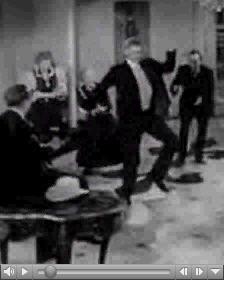
"Hoedown" [28 MB .mp4]
Flashback: published several years ago in preReview, the website that reviews movies before they come out. According to recent Lethem interviews, this project is still in the works:
Motherless Brooklyn
A "loose adaptation" of the Jonathan Lethem novel, written and directed by Ed Norton and set in the '50s rather than the present day. (No, not the Ed Norton that works in the sewers and is Ralph Kramden's best friend.) Norton also stars, as Lionel Essrog, a detective with Tourette's who tries to find his boss's killer. You think I'm kidding about Norton adapting this, but, no, I got all this info off of his personal website. Fans of the novel--stop crying, right now. Blow your nose and look on the bright side. What were some of the cooler things in the book? (1) The comedy of having a big pottymouth lug from Brooklyn entering a post-counterculture Upper East Side Zendo that may or may not be a criminal front, sitting crosslegged on a mat with the Roshi's exquisite disciples, and trying not to swear. (2) The incongruity of a '90s story with many characters and scenes apparently stuck in a weird '40s timewarp. (3) The quasi-generational tension between two brothers, one a Sopranos-style crook and the other a hippie Zen master crook (spoiler, sorry). (4) Smart, funny references to recent pop culture (Mad magazine's Don Martin, Prince) mediated through the main character's ongoing, inner-monologuic obsession with his own very of-the-moment disease. Well, by having it set in the '50s, all that stuff goes away, and/or makes no sense! Isn't that great? Don't you love it that rich Hollywood actors have the ability to destroy interesting books with their vanity projects? I sure do. prereviewer - Tom Moody, 03/09/04
"Eden Replica" [mp3 removed]
Update: Extended and remixed.
Conversation re: Ownership of the Web and its Data
from here via here:
Burak Arikan:One way not to be swallowed up is to make your site not very user friendly, keep your day job, and to be really honest about what you think (just a suggestion).
You've probably following the recent news about the small scale social web 2.0 companies being acquired by giant corporations (e.g., StumbleUpon acquired by Ebay, Feedburner acquired by Google). Feedburner tracks your blog's RSS feed statistics and shows the number of subscribers momentarily, daily, weekly, monthly, and yearly. Now all your data is changing hands, from Feedburner to Google.
Feedburner puts a notice in their sign in interface saying that you have a right to opt-out, delete your data. If you take no action by June 15, 2007 (9 days as of today), the rights to your data will transfer from FeedBurner to Google.
I wonder how you feel about it?
I think this is an important moment to pay attention to how inhumane the data ownership laws in USA: One who aggregates data owns it.
Trebor Scholz:
GOOGLE now owns Blogger, Writely, Dodgeball, Feedburner, YouTube, and Picasa. EBay took over Stumbleupon and Skype. YAHOO snatched up Facebook, Del.icio.us, WebJay, Jumpcut, Upcoming.org, and Oddpost.
Mr. Murdoch's NEWS CORP acquired MySpace, the video and photo-sharing site PhotoBucket and the media mash up site Flektor. It goes without saying that they already own Fox News and Fox TV, and a few good old publishing houses like Harper Collins, Daily Telgraph, The Times, New York Daily Post, The Sun, and The Australian.
Fox Interactive bought Photobucket, which is well-liked on MySpace. NewsCorp's effort is to make services on MySpace proprietary. This means that in the future, MySpacers, will not be able to plug in third party services. The goal is to create, popularize, and monetize in-house applications and then close the door to the wealth of the sociable web. Murdoch clearly does not get the sociable web as this direction will go at the expense of the teens on MySpace.
Ebay's acquisition of Stumbleupon, the web browser plug-in that allows its users to discover and rate web pages, is driven by a different impulse. Ownership of the company means access to the 2.5 million strong community using it and will help eBay to gain more exposure for their web pages, which will lead to more transactions. [...]
Burak asks if we should call it quits; good bye, Feedburner? No. How much of a chance is there for essentialist alternatives in a post-autonomy world? Today's small startup (i.e. http://www.feedwhip.com/) will be in the pocket of one media giant or the other by next month. [...]

The Art Guys, Disco Saw, 2007, 23 x 30 x 26 cm, circular saw, mirror tiles, lights, motor
from their exhibition at Galleri Andersson Sandstrom, Umea, Sweden, June 2 Ė August 17, 2007
Film recommendation of the month: Alejandro Jodorowsky's The Holy Mountain (1973). Still haven't seen his El Topo (unless multiple viewings of Greaser's Palace counts) but it just moved up my list. Mountain is the ultimate artist's movie--a staggering amount of work went into sets, costumes and props that are seen briefly and never again. Contentwise it fits the Alfred Jarry transgressive mold--much nudity, violence and swipes at church pieties. But it also parodies new age seekers of wisdom--the characters who announce their occupations and planets ("My planet is Uranus" etc) in a series of brilliant mini-biographies that are the heart of the movie. Their goal is to ascend the Holy Mountain with their mysterious guide The Alchemist (played by Jodorowsky) and displace the Nine Immortals--cowled figures sitting at a table like figures from Dali's Last Supper. The first 20 minutes or so of the movie presents a completely plotless succession of absurdist activities and tableaux, such as the "Toad and Chameleon theatre" featuring those critters dressed as soldiers and clerics, flipping around a tabletop in a chaotic "holy war." The rest veers between Bunuel (and occasionally Monty Python) surrealism and a kind of "60s swingers" vibe of polymorphous sexual antics, constantly changing course and subverting itself. Completely refreshing, and very likely something that could only have been made in the early '70s, before religious scolds of every denomination achieved a stranglehold on our discourse.
Slipstream fiction - bibliography; Bruce Sterling's original essay coining the term (and list of representative novels).
These are books which [science fiction] readers recommend to friends: "This isn't SF, but it sure ain't mainstream and I think you might like it, okay?" It's every man his own marketer, when it comes to slipstream.John Clute prefers the term "Fabulist," which sounds more like the known "Magic Realism," whereas I believe Sterling was really thinking his way around an unidentified genre.
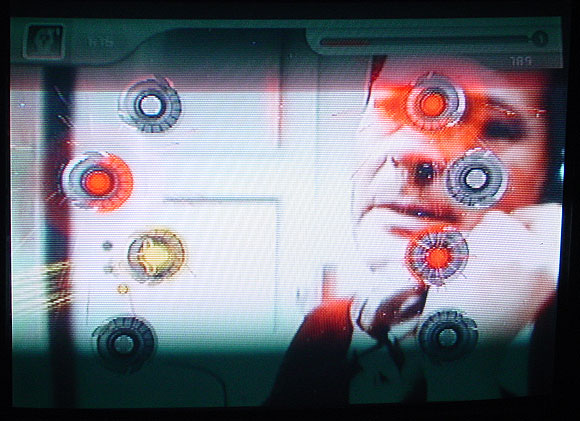
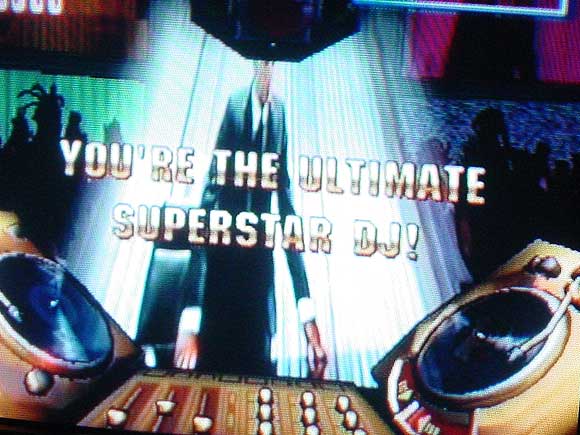
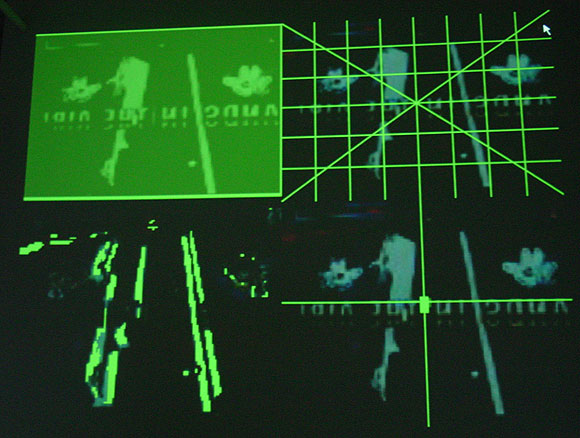
My photos of JODI's installation Composite Club at vertexList. The exhibit closes today--go if you can! Efrain Calderon Jr explains the art here; in a nutshell, it repurposes a game-related video camera (coupled with motion recognition software) called an "Eyetoy," designed to turn a child into a human joystick or data glove. As the kid moves head, arms, and torso, the camera reads the motion and a videogame makes countermoves, keeping the child physically active and away from the Doritos bag. Instead of kids, JODI has aimed the Eyetoy on films ranging from cyberpunk classics to Sophia Loren/Marcello Mastroianni romances. The movements of those films trigger video game actions, which are simultaneously layered over the films. Yes, this means you can watch Darth Vader play an anime ping pong player, but such one-to-one matchups happen only intermittently. (The bottom photo, a moving projection on the gallery wall, shows the various formal attributes the camera reads while the movie plays--screen position, light/dark values, etc. The top two are screenshots of "games" in progress.)
JODI (Dirk Paesmans and Joan Heemskerk) are the most painter-like artists working with computers and video today. Imagine Robert Rauschenberg using such tools at the time he did his "combines"--his work was called Neo-Dada and bridged Abstract Expressionism and Pop and that's essentially what JODI does now, with their densely layered amalgam of Japanese videogame weirdness and cult film cinematography, dissolving and mutating before your eyes. The conceit of the "the movie playing the game" isn't always comprehensible in these clips but for me this is a feature, not a bug. Art isn't about rubbing one ordered system up against another to get a third, but rather achieving an energized chaos that reveals something about the initial ordered systems, a la a Burroughs cut up. This revelatory randomness launches Composite Club beyond the pat realm of XYZ new media art. The artists use software like an auto-destructing Jean Tinguely painting machine and let chance processes do the work. They then discerningly edit motion captures of game play to make "best of" DVDs. The results are stunning--as good as anything you'll see in the galleries these days.
An earlier discussion, on why JODI isn't showing with one of the Manhattan cyber-galleries, is here.
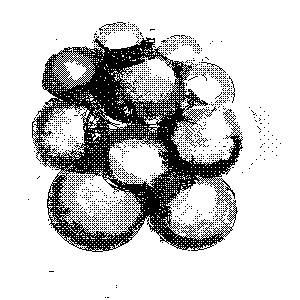
"sketchy" version of something posted earlier
"Junebug" [mp3 removed]
...have been having a congenial back and forth with a friend about whether the songs I post are music--he prefers "sound objects" because the structure is so clear. They are that, a little--I like transparency and think grid-based music software should sound like what it is and not some quantized, artificially natural thing. But I think they're music in the sense that techno music is music and have gotten more interested in structure since I first started posting. (Changing motifs makes the original motif sound better when you come back to it--what a concept.)
Blogosphere snapshot--obsessive/compulsive generosity:
Since a big issue was made here with massmirror and rapidshare let me myself explain why i prefer rapidshare:This sounds like a Billmon in the making--a blogger who completely overdid it, then harangued his readers about how hard it was, then loudly exited the Web (twice). I love mutantsounds but take a chill pill, y'all.
1.Rapidshare is still the most reliable host.I've tried Sharebee and proved to be total crap.Massmirror seems to be ok...for NOW.I don't know how it will be in a week or two.Those continously growing waiting times make me very suspicious.So i want some more time till i make a decision...massmirror has to prove it's stability and reliability.
2.Since our time is limited(and mine possibly motre than Eric's) and uploading one by one files takes much time.Rapidshare with rapidupload offers the option of massive uploads....using massmirror will make me spent more time on blog and "steal" this time from my family or time of rest( i already sleep about 4-5 hours per day due to blog...imagine what happens if i have to make uploads one by one).Someone could say lower the daily posts....that's totally out of question...i love music and i think both Eric and me have many many stuff to offer.A blog with one post per day or per week etc is a dead blog.Music is one of the things i could kill for or give my life for and i want to spread good music (IMHO) as much as possible....Besides the posts are from too many genres that no one is obliged to d/l all our daily posts.I hope you understand why i'm still on rapidshare...BUT once Massmirror proves it's stability and reliability i will turn to this .
Thanks for your support and love.
Jim Mutantsounds
Baramin...good grief, I'd never heard that term
From the Boston Globe:
Conservapedia is just like Wikipedia, except that its 11,000 entries read like they were personally vetted by Pat Robertson and the 700 Club. Fed up with Wikipedia's purported liberal bias, Conservapedia's founder, Andrew Schlafly, son of conservative activist Phyllis Schlafly, has created "an encyclopedia you can trust."This would be funny if these people weren't so sad, and such fascists. Baramin--sounds like "varmints" but it's supposedly based on Hebrew.
And you can trust them, to give you some pretty loopy definitions. Their entry on kangaroos, for instance, says that, "like all modern animals . . . kangaroos are the descendants of the two founding members of the modern kangaroo baramin that were taken aboard Noah's Ark prior to the Great Flood."
You may not recognize the word "baramin." It's a 20th-century creationist neologism that refers to the species God placed on earth during Creation Week. Special for kids: I wouldn't use that word on the biology final. Although maybe your parents could sue the local school board for failing to teach the Book of Genesis in science class.
More on Conserva-kangaroos: "After the Flood, these kangaroos bred from the Ark passengers migrated to Australia. There is debate whether this migration happened over land with lower sea levels during the post-flood ice age, or before the supercontinent of Pangea broke apart, or if they rafted on mats of vegetation torn up by the receding flood waters."
Who knew?
Some excellent clone-hunting going on at VVork: stacks of audio loudspeakers (1, 2, 3, 4, 5) and stacks of books (1, 2, 3, 4, 5) by artists. A while back it was "neon week."
"I feel that my stack of loudspeakers is more profound than yours because..."
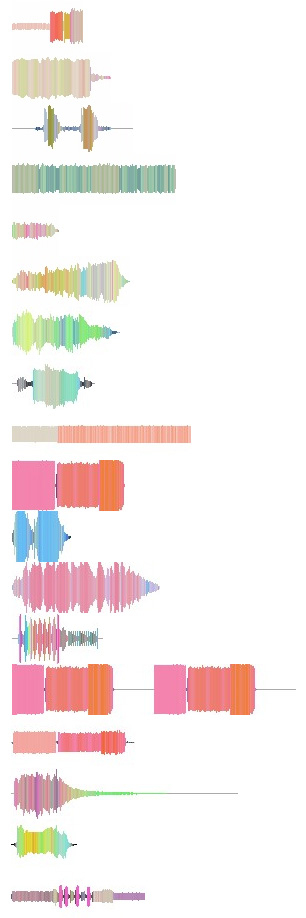

Marisa Olson Collections 1: Sound Files
images Olson posted to Nasty Nets, reBlogged






Marisa Olson Collections 2: Knives





















Marisa Olson Collections 3: Knots
A week or so ago Atrios linked to this Charlie Rose interview with Thomas Friedman, a New York Times columnist and ostensible Middle East expert, which aired in 2003, right after America thought it had "won" the Iraq war. Watch it if you can without hurling. Friedman condescendingly lectures people in Muslim countries, bragging shamelessly about the lessons "American boys and girls" have taught them. It never seems to occur to him that four years later Iraq might be a charnel house because of his and Bush's bad judgment call. (The US service deaths passed 3500 this week.) His jingoist cry that "American power in the service of American ideals" had to teach a lesson to a Muslim country--any Muslim country, it doesn't matter if it attacked us or not--is pure Rudyard Kipling racism. This was him at the height of his post shock and awe preening but he still hasn't apologized for all the people he helped to kill. Here's what he said:
What they needed to see was American boys and girls going house to house, from Basra to Baghdad, um and basically saying, "Which part of this sentence don't you understand?"Retribution against the wrong country for 9/11 was bad enough without claiming it as a triumph for American ideals.
You don't think, you know, we care about our open society, you think this bubble fantasy, we're just gonna to let it grow?
Well, Suck. On. This.
Okay.
That Charlie was what this war was about. We could've hit Saudi Arabia, it was part of that bubble. We coulda hit Pakistan. We hit Iraq because we could.

Two fairly active threads on Cory Arcangel, Paul B. Davis, and matters BEIGE: the conversation starts here and seems to be continuing here. So far Paddy Johnson's questions from last fall--about Untitled Translation Exercise in particular--aren't being answered, although some good points have been made overall. Once again some fairly persistent commenter(s) are avoiding the issues and accusing me of personal belligerence and hostility. This rather proves my point that the discussion around BEIGE these days isn't about issues but about declaring for or against certain artists. We need to get over this.
Update: A couple of comments about UTE have been made since I posted.
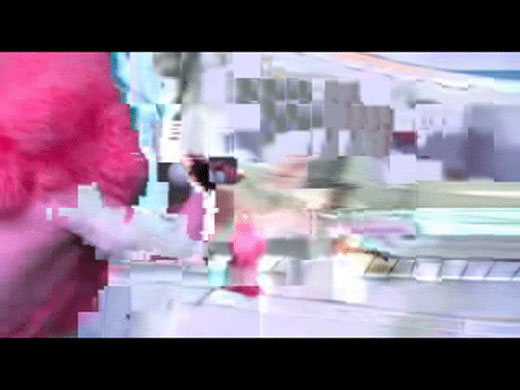
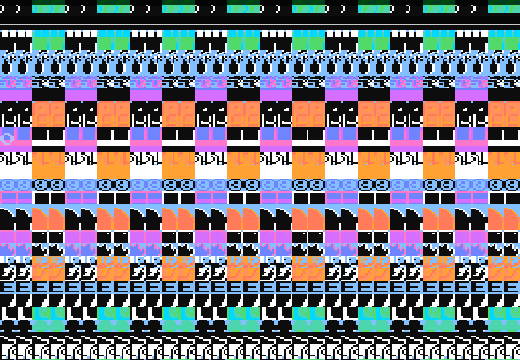
Meanwhile, in an alternate universe where more than one artist using the computer broke through to staggering international recognition, making new media people all jumpy and feeling like they had to "declare":
PAUL B. DAVIS [BEIGE]I fondly recall the turntable with the 8-Bit Construction Set LP in the front room of the old Team Gallery, crammed with other BEIGE work.
INTENTIONAL COMPUTING
Seventeen Gallery, London, 30th May Ė 23rd June 2007
Paul B. Davis is obsessed with computers and makes art that helps him understand how they work. Heís a founder member of the pioneering programming ensemble BEIGE along with Cory Arcangel, Joe Beuckman and Joseph Bonn.
This exhibition comprises two large projections. Five in One, 2007 is a new NES hack that takes its form from the pirate video game cartridges that first alerted Davis to the possibility of intervening with games. These Ďmulticartsí often had for or five different games on one cartridge and echoing this, Davis is presenting five different works on one machine. Fittingly these pirated works are not all by Davisí hand, as he loots excerpts from other BEIGE collective hacks, questioning authorship in the already grey area of software as readymade. The second piece is a new video, a collaboration with the trans-media collective Paper Rad, which accentuates and aesthecises artefacts inherent in video compression formats, particularly MPEG-4 [titled Video Compression Study II, 2007]. A third work, in collaboration with Cory Arcangel, titled Fat Bits, is a triptych of monitors which presents close up images of an NHL ice hockey game, converted into imagery housed in an NES. Reminiscent of the timeless NES Ice Hockey game, these abstracted motions of brawling figures present a bacon-esque scene, groaning and grunting in a slow motion and distorted struggle.
Aesthetically Davisí images are solid slabs of reordered, pure proto-modernist colour. With his alterations a new game, a new screen and a new surface emerges. The materiality of a hacked game cartridge, set into the instantly recognisable Nintendo console, guarantees that the recession into a purely two-dimension digital fold is never as total as it is in the work of other digital artists, the work remains an object. Further, the dizzying hyper-graphics of many related practitioners are surrendered in favour of the neat, blocky pixilation of the outdated NES operating system. This show also includes an installation featuring 8-bit Construction Set Ė an art/music/concept work rendered in vinyl which will be mounted on a record deck within the gallery, visitors being invited to play it out to their own satisfaction.
Quoting his influences as ranging from formalised British computing theory (Alan Turing) to the advent of widespread domestic console gaming (Mario), Davis has pioneered a truly unique strategy through a multiplicity of actions, networks and artistic creations. Davisí practise is at once rigorous, conceptual Ė even nerdy, while nonetheless fully intimate with the patois, style, attitude and aesthetic of retrogressively inspired, data-bit multi-media contemporary culture, that has recently forced its way into the public consciousness.
Below is Paddy Johnson's review of Cory Arcangel's "...participatory culture" show at Team Gallery last year. While critical, it is ultimately respectful and merely expresses what many thought about the show but were too cautious to say for fear of jinxing the first non-sucky computer artist to break through to art world recognition. Including me, even though I felt the show was a step back to the "BitStreams" era. I'm bringing it up now because recent writing about the artist seems to be adopting a strangely defensive or belligerent tone--it's as if you have declare whether you're for or against him, and I think we need to get over this. This review was not reBlogged by Eyebeam or Rhizome, the main new media sites, which also seems like a partisan and slightly juvenile snub. The issues are worth discussing.
I have been spending a lot of time thinking about how to discuss New Media artist Cory Arcangelís new exhibition, subtractions, modifications, addenda, and other recent contributions to participatory culture at Team Gallery, and itís not the exercise in fun it usually is. Writing about my friends is great when Iíve only got compliments to bestow, but itís another ball of wax when I leave their exhibition with a mental list of artists who have done similar work.Donít get me wrong, subtractions, modifications, addenda, and other recent contributions to participatory culture, isnít entirely derivative, nor is it a bad show per say, but it does inspire a number of questions, that arenít easily resolved. Probably the strongest work in the show is Untitled Translation Exercise, a modified version of Dazed and Confused, a film by Richard Linklater, which now features the redubbed voices of Indian actors performing the screenplay in English. The original movie is a coming of age story about a group of American high schools students experiencing the anxiety, boredom, and fervor of teenage years, so Arcangelís choice to outsource the dialogue, both heightens the viewerís sense of what it means to be American, and reflects the development of new industries in the United States.
Youíd think these ideas would be enough to stamp the piece as good and be done with it, but I canít reconcile the feeling that the decision to outsource the filmís dialogue isnít entirely resolved. There are simply too many loose ends at play here. What does the work gain by outsourcing labor that has already been completed? Was it necessary to make a feature length movie? Does the filmís narrative support the alteration? These questions donít come up in Woody Allenís similarly conceived, Whatís Up Tiger Lily, a 1966 film whereby the director purchased a Japanese spy movie, removed the sound track and replaced it with his own. Clearly the two films are different, but you canít say the approach doesnít, at the very least, merit comparison.

The other video based works in the exhibition do not invite specific film references the way Untitled Translation Exercise does, but they do seem awfully close to work that has already been made. Arcangelís Colors for example, extends pixels line by line in the Dennis Hopper movie by the same name to create a moving vertical pattern reminiscent of New Media artist Jason Salavonís The Top Grossing Film of All Time 1◊1. Exhibited in 2001 at the Whitneyís exhibition Bitstreams, the artist uses the average color of each frame in the movie Titanic, and arranges them in a digital c-print to follow the narrative sequence they would have appeared in. I suspect the programs each artist wrote to create their work were difficult to execute, but unlike the work of Salavon, those with even a small amount of website construction experience will be familiar with the technique of expanding pixels, and subsequently wonít find the Arcangel manipulation all that interesting. Even without this knowledge, I imagine many viewers will still be left wondering what the point of the alteration is (other than to create a moderately attractive picture).
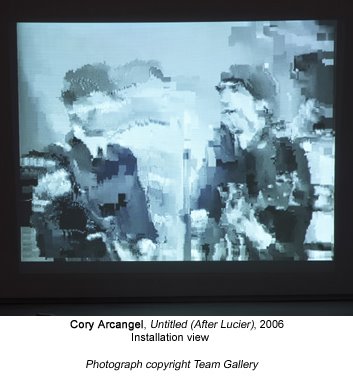
The reason these issues exist in this work, as with Untitled (After Lucier), a video loop of the Beatles on The Ed Sullivan show which compresses and loses image quality with each repetition, is that in each case, the content is subservient to the technology. And unfortunately, just as painting about painting is dull, so is tech art about tech. The thing is, Arcangel knows this, so despite the fact that some of the work in this show falls short, I have trouble believing that the exhibition is some sort of sign of things to come. Two weeks ago at Vertexlist, the artist performed pieces from his record The Bruce Springsteen ĎBorn To Runí Glockenspiel Addendum (also part of his show), and while, I canít claim to understand why the record needed to be a remix album (the artist composed five Glockenspiel pieces for the Bruce Springsteen album Born to Run, in addition to the three Springsteen had already written, matched them to the time count of the music, and removed the original music), his performance demonstrated his usual brilliance. There was a charming awkwardness to his playing, which made the piece at once humble, moving, and strangely funny. In fact, it was so enjoyable, that the thought occurred to me that while subtractions, modifications, addenda, and other recent contributions to participatory culture, isnít the best thing the artist has ever done, if he had thrown a performance into his show, nobody would have ever known the difference.

Calling Cthulhu by Erik Davis:
For [H.P.] Lovecraft, scientific materialism is the ultimate Faustian bargain, not because it hands us Promethean technology (a man for the eighteenth century, Lovecraft had no interest in gadgetry), but because it leads us beyond the horizon of what our minds can withstand. "The most merciful thing in the world, I think, is the inability of the mind to correlate all its contents," goes the famous opening line of "Call of Cthulhu." By correlating those contexts, empiricism opens up "terrifying vistas of reality"ówhat Lovecraft elsewhere calls "the blind cosmos [that] grinds aimlessly on from nothing to something and from something back to nothing again, neither heeding nor knowing the wishes or existence of the minds that flicker for a second now and then in the darkness."Davis's essay considers the before-and-after role of religion in HPL's prose: elements of magic and ritual appropriated by the author for his world of materialistic horror as well as attempts by various cults and Internet wackos to claim the Necronomicon as an authentic text. The in-depth research illuminates but possibly ameliorates Lovecraft. Davis's emphasis on the "Outside Within," a domain of eldritch visions that can be instructive as well as devastating to the religious seeker, breaks the spell that HPL is indeed describing malevolent conspiracies beyond the control of our Enlightened societies and diminishes his central insight: that these forces are real. (Cue organ.) I prefer the political dimension that some writers have claimed for the Providence recluse, such as Robert Bloch's litany of "modern horrors" not generally cognizable at the time Lovecraft wrote his stories but making him only too relevant to current readers: serial killers operating in the cracks of civilization, technologically assisted genocide, horrors beyond our capacity to absorb horror--to which one might add the televised mass chaos post-Katrina and the drill-killing insanity in Iraq unleashed by Dick Cheney, the ultimate Lovecraftian leader.
Lovecraft gave this existentialist dread an imaginative voice, what he called "cosmic alienage." For Fritz Leiber, the "monstrous nuclear chaos" of Azathoth, Lovecraft's supreme entity, symbolizes "the purposeless, mindless, yet all-powerful universe of materialistic belief." But this symbolism isn't the whole story, for, as DMT voyagers know, hyperspace is haunted. The entities that erupt from Lovecraft's inhuman realms seem to suggest that in a blind mechanistic cosmos, the most alien thing is sentience itself. Peering outward through the cracks of domesticated "human" consciousness, a compassionless materialist like Lovecraft could only react with horror, for reason must cower before the most raw and atavistic dream-dragons of the psyche.
Modern humans usually suppress, ignore or constrain these forces lurking in our lizard brain. Mythically, these forces take the form of demons imprisoned under the angelic yokes of altruism, morality, and intellect. Yet if one does not believe in any ultimate universal purpose, then these primal forces are the most attuned with the cosmos precisely because they are amoral and inhuman. In "The Dunwich Horror," Henry Wheeler overhears a monstrous moan from a diabolical rite and asks "from what unplumbed gulfs of extra-cosmic consciousness or obscure, long-latent heredity, were those half-articular thunder-croakings drawn?" The Outside is within.
[Thanks to Davis for the shout to this blog a while back--I'm disagreeing with him a bit here but his nod made my week--Techgnosis is awesome.]
Photo: Cthulhu (and other carvings against uniformly blue backgrounds) from Monolith Design. "Monolith Design was founded in 1990 by Stephen Mussared and is committed to producing carefully researched, well-made gaming miniatures for a wide variety of scales and periods, from Ancient Egyptian through Twentieth Century to Science Fiction and Fantasy. The models are cast in high quality resin [...]" [via travis about two years ago]


Belatedly posting my tourist photos from the National Museum of the American Indian on the Mall in DC. Forgot to bring the USB cable for my camera when posting from the road--this was almost like getting snapshots from the drugstore after the trip. That's beadwork in the top picture--I love the calmness and focus of the pattern. Below is the sci fi ceiling of the space-hogging but dramatic atrium. The outside is kind of spacy too but it's adobe-oid so it's not too anomalous. One supposes the atrium mimics an igloo but its lines are predominantly modernist. [Friends, family in DC please don't be mad if I didn't reach you--this was a brief stopover on the way down to Charlottesville for my college radio station reunion.]
Update: We're discussing the premises of the museum here.

Juan Cole on Iran war propaganda:
Polling shows that the percentage of Americans who view Iran as the number one threat to the United States has risen to 27 percent now. I think it was only 20 percent in December 2006. First of all, how in the world can a developing country with about a fourth of the population of the US, about a $2000 per capita income (in real terms, not local purchasing power), with no intercontinental ballistic missiles, with no weapons of mass destruction (and no proof positive it is trying to get them), with a small army and a small military budget-- how is such a country a "threat" to the United States of America? Iranian leaders don't like the US, and they talk dirty about the US, and they do attempt to thwart US interests. The same is true of Venezuela under Chavez. But Tehran is a minor player on the world stage, and trying to build it up to replace the Soviet Union is just the worst sort of fear-mongering, and it is being done on behalf of the US military industrial complex, which wants to do to Iran what it did to Iraq. It is propaganda, and significant numbers of Americans (a 7 percent increase would be like 21 million people!) are buying it.Many higher ups in media and the government don't know the difference between Sunni Muslims (comprising most of the Iraq insurgents) and Shiite Muslims (comprising the majority of Iraqis and almost all Iranians). Or that Iranians are Persian, not Arab. How can millions of Americans understand that if it isn't explained to them?
Why have those poll numbers gone up? Because the Bush administration is trying to hang the Sunni Arab insurgency in Iraq on Iran (and even trying to hang the Taliban resurgence in Afghanistan on Iran). The message of administration and military spokesmen is that Iran is deliberately killing US troops and is a major source of insurgency in Iraq. No convincing evidence has ever been presented for either allegation, nor is it reasonable to assume that Iran plays a significant role in funding hyper-Sunni, Shiite-killing death squads to deliberately destabilize its client governments in Baghdad (al-Maliki) and Kabul (Karzai). Yet the New York Times and even the Guardian put this b.s. on the front page, and of course it is all over CNN, Fox Cable News, MSNBC, etc. Are US journalists trapped in the the dictates of the military-industrial complex by virtue of working for these mega corporations? We know that Roger Ailes at Fox Cable News orders his employees how to spin the day's news (he is a former high Republican Party official). Has any of the journalists counted up how many of the 127 US troops killed in Iraq in May was killed in Sunni Arab areas and how many in Shiite neighborhoods? Has any of them actually read the translated communiques on World News Connection of the Sunni Arab guerrillas and what they say about Iran and Shiites? Has any demanded air tight proof and non-anonymous sources before printing this garbage?
No.
Rest in Peace, Steve Gilliard.

The best, most honest, least compromising political blogger, Steve Gilliard, has died. He had a devastating sense of humor and no careerist agenda beyond excellent writing and saying exactly what he thought. Meaning that, unlike DailyKos or MyDD, he didn't use his blog for political activity and he didn't hang with politicians. He also wasn't looking to "move up" to the mainstream media--in fact, he often boasted that his readership was as large as many lefty print mags, so why did he need to join them? And he didn't just vent, he did his homework--for example, a memorable, well-researched series on the history of colonial warfare, from a strategic viewpoint. Reading those case studies helped you to recognize the Iraq War for what it is and also, strangely optimistically, to know that it is a 19th Century relic and therefore doomed (if optimism is the right word for an experiment with such a great human cost). Gilliard remains an inspiration and an ethical yardstick for all attempting to step out of established modes of communication. He will be celebrated long after the Tim Russerts and Peter Beinarts are forgotten jokes of history.
(photo by Lindsay Beyerstein)
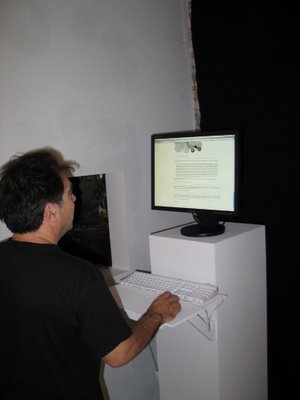
Was hoping to get this photo posted before the gallery closed today but have been on the road. Missed it by 14 minutes. Next week for sure for one ultimate self referential feedback loop post for BLOG, the exhibition. Photo of seminal conceptual artist from Aron Namenwirth's blog.

















































GIF grid by eyekhan
not ideal in RSS readers
Am currently in Charlottesville, VA, attending an anniversary event for the college radio station WTJU, where I DJ'd for several years and enjoyed a couple of bracing years of administrative responsibility (as program director). 'TJU is much like WFMU in NY*, a free form format with knowledgeable volunteers as jocks. When I was in school it was entirely student run and thus a creatively fertile chaos, but it has since hired a station manager who miraculously is not a micromanager and lets the volunteers continue to shape the content. Charlottesville is beautiful but barely recognizable from my student days for all the growth. It has been touted as a perfect city so of course everyone wants to move there.
*metropolitan area
Reporting from Washington DC. Checked out the newest addition to the Smithsonian's museums on the Mall: the National Museum of the American Indian. Dramatic yellow adobe modernist building with the obligatory giant atrium, nice for the architect's portfolio but hogging much of what could have been exhibit space. Some wonderful collections of objects such as a show of women's apparel with intricate beadwork and concentric rings of elks' teeth (only two of such teeth per elk, so the more rings the mightier the woman's husband's hunting prowess, according to the video). Unfortunately most floors gave prominence to exhibition design over artwork, presenting crowded mazes of computer-generated text-and-photo spreads and interactive video terminals. Actual artifacts, darkly lit against darker backgrounds, tended to be swallowed up in these seas of typography. Other problems: vague and blandly worded themes ("our people," "our universes"), no clear timelines or sense of geography, avoidance of any kind of overall narrative history. Haven't researched the politics of how the museum came together and what kinds of compromises had to be made (either among tribal interests or to sidestep the U.S.'s sordid past of mass native American disenfranchisement), but the murkiness of the design seemed purposeful. Not to overlook the simple problem of "too many cooks" in the layout or the ever-ascendant tendency of designers to think they're artists and overwhelm the actual artwork on display.
Belatedly posted photos here.
Documentation of my work in the "Fresh NY" show at Threshold Art Space, Perth, Scotland. Eleven of the 22 screens are shown. Photos by exhibition curator Anne Barlow. The OptiDisc GIF below is reduced; clicking on image shows the actual size (of the GIF--the screens are much larger).

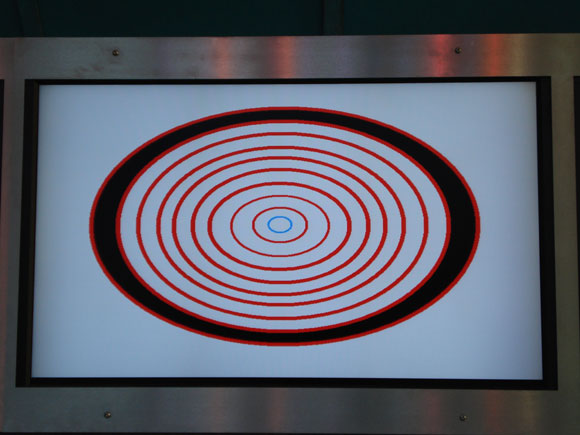
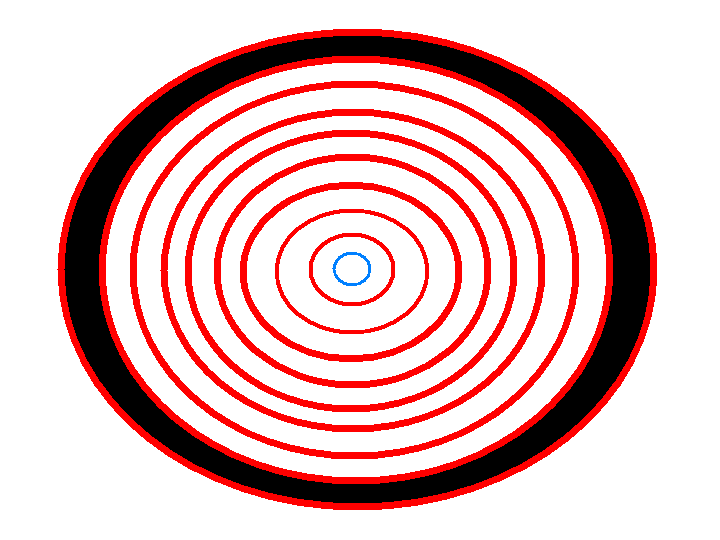
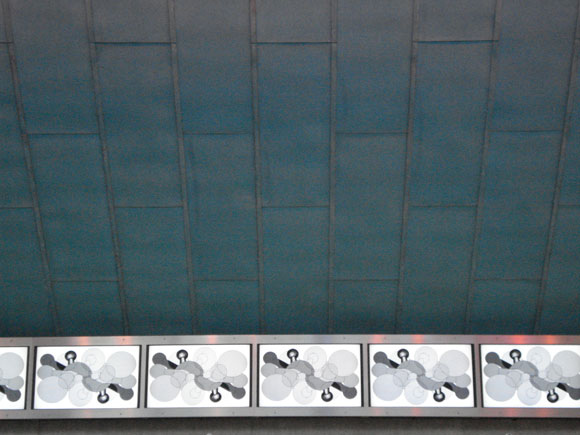
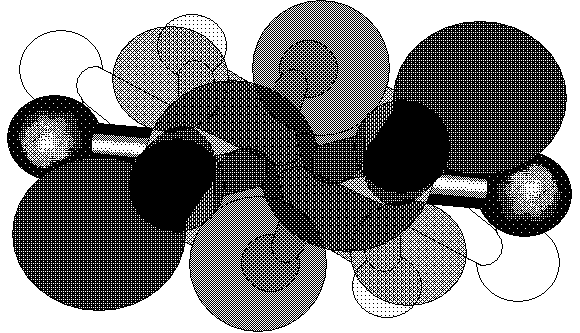
return to main site

